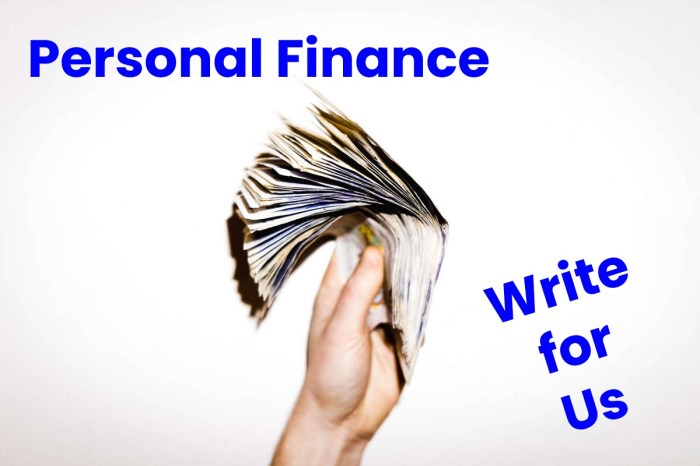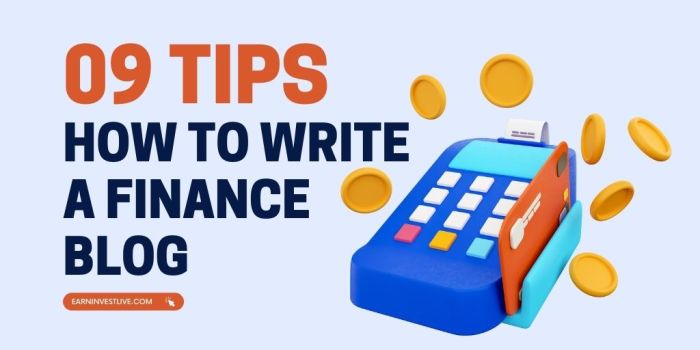Writing a Personal Finance Blog dives into the world of blogging about money matters, offering insights on how to captivate your audience and maximize your blog’s potential. Get ready to learn the ropes of financial blogging in style!
From setting up your blog to monetization strategies and building a strong community, this guide has got you covered with everything you need to know to make your personal finance blog a hit.
Setting Up Your Personal Finance Blog

When starting your personal finance blog, setting up the foundation is crucial to attract and retain your audience. Choosing a niche, selecting the right domain name, and picking a reliable web hosting service are key components to consider.
The Importance of Choosing a Niche for Your Blog
Finding your niche in the personal finance blogging world is essential to stand out from the competition. Whether you focus on budgeting tips, investing strategies, or debt management, selecting a specific area of personal finance will help you target the right audience and build your expertise.
Selecting a Domain Name that Resonates with Your Audience, Writing a Personal Finance Blog
Your domain name is your online identity, so it’s important to choose one that reflects the content and purpose of your blog. Make sure it is easy to remember, relevant to your niche, and resonates with your target audience. Avoid using numbers or hyphens, and opt for a domain extension like .com for credibility.
Tips on Selecting a Reliable Web Hosting Service
When choosing a web hosting service for your personal finance blog, reliability and performance are key factors to consider. Look for a hosting provider that offers good uptime, fast loading speeds, security features, and excellent customer support. Compare different hosting plans to find one that suits your blog’s needs and budget.
Creating Engaging Content
When it comes to creating engaging content for your personal finance blog, it’s important to consider the types of posts that will resonate well with your readers. By providing valuable and relatable information in an interesting format, you can keep your audience coming back for more.
Listicles
Listicles are a popular format for personal finance blogs because they break down complex information into easy-to-digest lists. For example, you could create a post on “10 Money-Saving Tips for College Students” or “5 Ways to Increase Your Savings Account.”
- Include actionable tips and advice
- Use catchy titles to grab readers’ attention
- Add relevant images or infographics to enhance the content
Case Studies
Case studies are another effective way to engage your audience by providing real-life examples of financial successes or challenges. You could share a detailed account of how someone paid off their debt or achieved a financial goal, offering insights and lessons learned along the way.
- Highlight the key takeaways from each case study
- Show the before-and-after results to demonstrate progress
- Add quotes or testimonials for authenticity
Tutorials
Tutorials are valuable for personal finance blogs as they provide step-by-step guidance on specific financial topics. You could create tutorials on budgeting, investing, or retirement planning, offering practical advice that readers can implement in their own lives.
- Break down complex concepts into simple, easy-to-follow steps
- Include screenshots or video tutorials for visual learners
- Encourage reader interaction by asking for feedback or questions
Monetization Strategies

When it comes to monetizing a personal finance blog, there are several strategies you can explore to generate revenue and make your blog profitable. These strategies include affiliate marketing, sponsored content, and selling digital products. It’s essential to choose the right monetization methods that align with your blog’s niche and audience to maximize your earnings while maintaining the integrity of your content.
Affiliate Marketing
Affiliate marketing is a popular monetization strategy for personal finance blogs. By partnering with companies and promoting their products or services through affiliate links, you can earn a commission for every sale or lead generated through your referral. It’s crucial to disclose your affiliate relationships transparently to your audience to build trust and credibility.
- Choose affiliate programs that offer products or services relevant to your audience’s interests and needs.
- Focus on promoting high-quality products that you genuinely recommend and believe in to maintain your credibility.
- Track and analyze the performance of your affiliate links to optimize your strategy and increase your earnings.
Sponsored Content
Sponsored content involves partnering with brands or companies to create blog posts or articles that promote their products or services in exchange for a fee. When collaborating on sponsored content, it’s essential to ensure that the content aligns with your blog’s values and provides value to your audience to maintain their trust.
- Clearly disclose sponsored content to your audience to maintain transparency and credibility.
- Negotiate fair compensation for your sponsored posts based on factors such as your blog’s reach, engagement, and the amount of effort required to create the content.
- Select sponsors that align with your blog’s niche and audience to ensure relevance and authenticity.
Selling Digital Products
Selling digital products such as e-books, courses, templates, or printables is another effective way to monetize your personal finance blog. Creating valuable and informative digital products that address your audience’s pain points can help you generate passive income and establish your expertise in the finance niche.
- Research your audience’s needs and preferences to create digital products that provide practical solutions and valuable insights.
- Promote your digital products through your blog, email marketing, and social media to reach a wider audience and drive sales.
- Offer discounts, promotions, or bundles to incentivize your audience to purchase your digital products and increase your revenue.
Building a Strong Community: Writing A Personal Finance Blog
Building a strong community around your personal finance blog is crucial for long-term success. Engaging with your audience through comments and social media can help foster a sense of connection and loyalty. By actively responding to comments and messages, you show that you value your readers’ input and are willing to engage with them on a personal level.
Growing Your Email List
To grow your email list, offer valuable content upgrades such as free e-books, checklists, or exclusive tips in exchange for email sign-ups. Make sure to place opt-in forms strategically on your blog and promote them through social media and other channels. Once you have a list of subscribers, nurture these relationships by sending regular newsletters with helpful content, updates, and special offers.
Organizing Finance-Related Webinars or Events
Hosting webinars or live events is a great way to connect with your audience on a deeper level. You can invite guest speakers, conduct Q&A sessions, or provide in-depth tutorials on various financial topics. Promote these events through your blog, social media, and email list to maximize attendance. Interacting with your audience in real-time can help build trust and establish you as an authority in the personal finance niche.